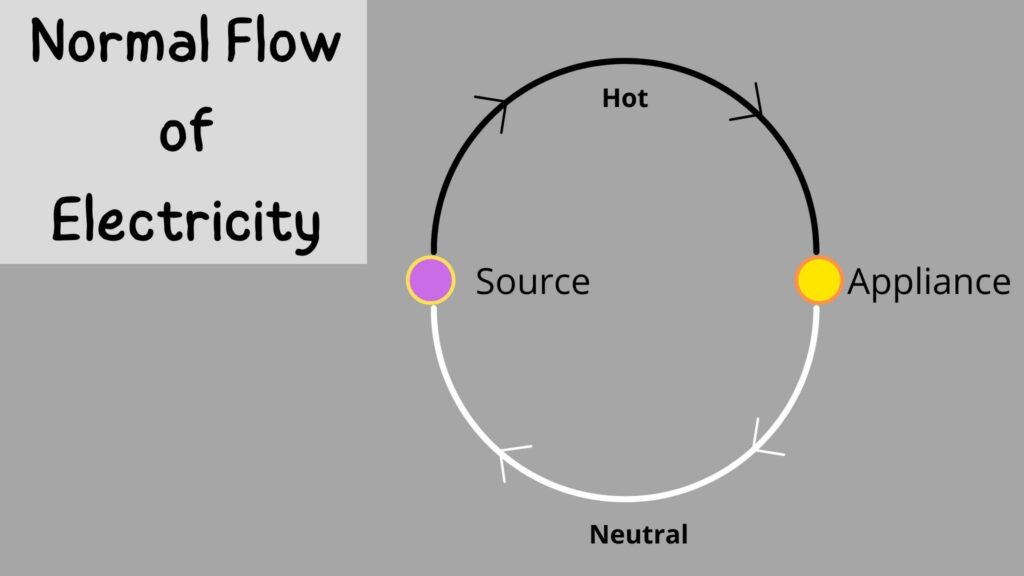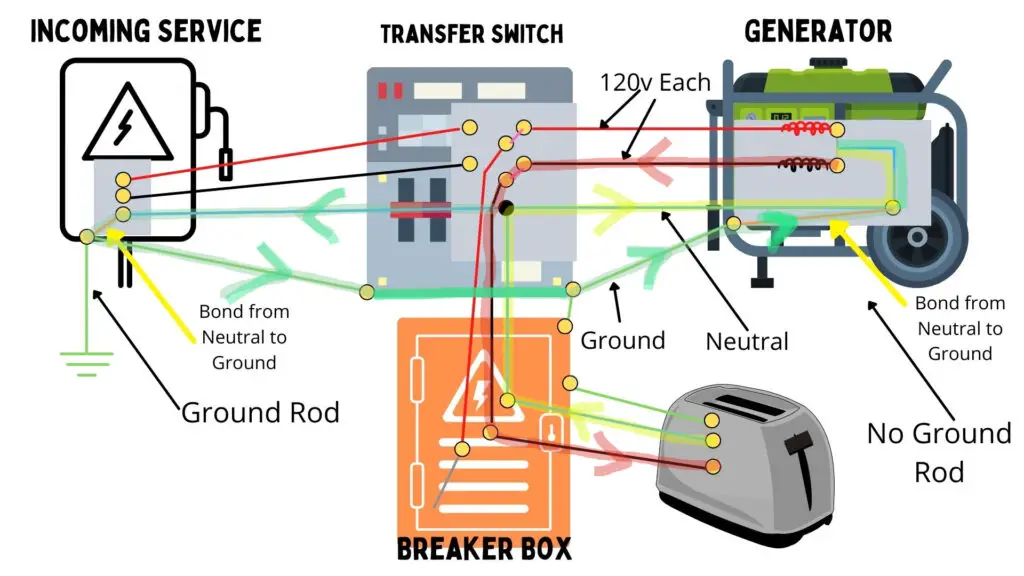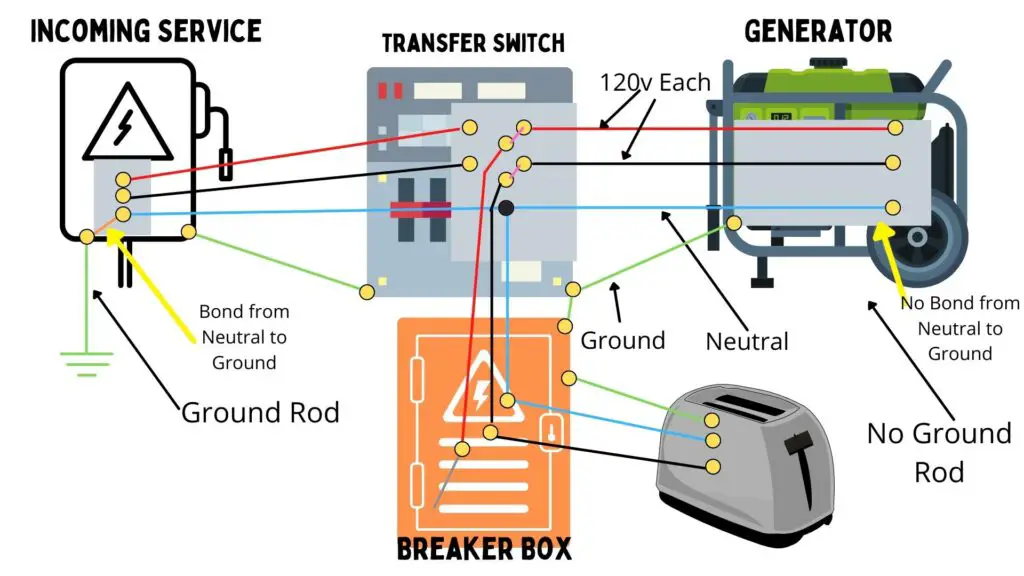When you’re shopping for a generator for electricity backup, you’ve likely noticed that on the displays of all the models they’ll either say “floating neutral” or “bonded”. This is not just a trivial claim for you to gloss over — it has real life safety issues depending on how you plan on using your generator.
Most generators for home owners will have a floating neutral since it is required for most backfeeding setups when powering a house during a power outage. A system can only have one place where the neutral and ground are bonded, and a house is already bonded. Adding a generator with a bond to the mix would create parallel paths for the return current back to the source and this could lead to a fire hazard.
Let’s quickly cover what a floating neutral means, when to use a floating neutral generator, how to identify a floating neutral, and whether they are safe or not.
As a disclaimer, you should consult with your local licensed electrician before making any changes to your electrical setups.
What Does Floating Neutral Mean on a Generator?
When a generator is floating neutral, it means that the neutral and the ground circuits do not touch in any way. More specifically, the grounding (ground wire) and grounded (the neutral) conductors are separate. Since the ground wire is used as an emergency path for fault current back to the source, a floating neutral means that the fault current does not have an emergency return path.
If you’re new to this concept, that probably doesn’t help you at all.
Let’s break it down in simpler terms with an example using 120-volts (normal household power in the USA).
Imagine a circle (circuit) with two nodes on the circle that are opposite from each other. One node is the source of the power (your generator) and the other is the appliance being powered.

Electricity must be able to flow from the source to the appliance on the hot wire (where it does work) and back to the source on the neutral wire in order for the flow to actually occur. If there is a break in one of these two wires, then the flow of electricity stops unless something can conduct the electricity between the break.
Now, in a house this would not occur (or with a generator that is “bonded”). In this case, let’s say that the hot wire became disconnected in the appliance itself. It would no longer be connected to the neutral and would instead energize the frame of the appliance. From here, the ground wire is already connected to the frame so the electricity would travel down the ground wire and back to your circuit breaker box (or bonded generator).

The reason it can travel down the ground wire is because the ground wire and the neutral wires are bonded — they are physically linked — at the main breaker (or in your bonded generator if you’re using extension cords). Since they are linked, the current goes from the ground wire, to the neutral wire, and then back to the source’s windings to complete the circle (circuit).
The purpose of having a breaker that you turn on and off is to ensure that the electricity is actually doing work and not experiencing a fault. When the return current travels along the emergency path (ground wire) back to the source without doing any work in the appliance, the internal wiring and magnets in the circuit breaker will sense in a millisecond that no work is being performed and the breaker will “trip”, or turn off, in order to save anyone from electrocution.
If we jump back to our “floating neutral” generator, the emergency path is never taken because the ground does not link back up with the neutral. Electricity is essentially backed up and has potential, but is unable to flow.
In our previous example, the hot wire would be energized, and frame of the appliance would be energized, the ground return wire would be energized, and the frame of the generator would be energized (since the ground wire is bonded with the frame) but the electricity would be backed up like with a dam and couldn’t flow since it cannot reach the source.
So, to recap, a floating neutral does not allow an emergency path for a fault to travel back to the source and therefore will not trip the breaker. A bonded generator (or a house) will provide that emergency path since the neutral and ground wires are physically bonded at the source and a breaker will trip if there is a fault.
When Would You Use a Floating Neutral Generator?
Now that you understand that a floating neutral does not allow a return path for fault current back to the source in order to trip the breaker, and that a bonded generator does, you’re naturally going to wonder why we would ever want to use a floating neutral generator in the first place.
Floating neutral generators are made for backfeeding power to a house through a transfer switch or interlock kit.
The reason for this is because your house, by code, already has a bonded neutral and ground. In a system there can only be one point where this bond takes place. When you backfeed power back to a house from a generator, you’re still using the wiring inside the house even though you’ve turned off the mains power from the utility company, so the neutral-ground bond is still in place.
If you introduce two bonding points, then electricity will take parallel paths back to the source when there is a fault.
It’s hard to imagine without seeing a diagram, so feel free to check them out below.

A floating neutral generator should always be used for backfeeding a house except when you have a switched-neutral transfer switch that switches over the hots AND THE NEUTRAL (instead of just the hots like most transfer switches). A switched-neutral transfer switch makes it so that the generator no longer has access to the house’s bonding point and the generator must now be bonded to allow an emergency return path back to the source.
Most transfer switches don’t switch the neutral, but if you’re unsure about yours you should consult your local licensed electrician.
If you want to know more about floating neutral, bonded, and if you need a ground rod installed with your generator, check out my article here and video below.
How Do I Know if My Generator is Floating Neutral?
The easiest way to verify that your generator is floating neutral is to use a basic multimeter and test for continuity between the neutral slot and the ground pin slot on the generator’s receptacles (while the generator is off). You can also test from the neutral’s slot on the receptacle and the grounding post near the generator’s main panel (the place where you could attach a ground wire and ground electrode).
You’ll set the multimeter to continuity (the horseshoe shaped symbol), touch both leads together to verify that they beep when they touch, and then test the areas I mentioned in the previous paragraph. If they beep, then you have a bonded generator. If they don’t beep, then your generator is floating neutral.

Do NOT trust that a generator is bonded or floating neutral just because the generator panel (or the manual) says so. Many generators are made abroad these days and I don’t know what gets lost in translation but they are simply not as advertised.
WEN generators are guilty of this a lot. I’ve come across 3 WEN generators that were supposed to be bonded but were indeed floating neutral (that way from the factory).
Always verify before using!
Are Most Generators Floating Neutral?
Most generators sold for household use will come as floating neutral, since the manufacturer assumes that they will be used to backfeed power to a house which is already bonded. This is especially true for generators that are 5,000 watts (5kW) or less.
Generators that are larger, or those intended for construction site use are typically bonded, as it is often a requirement by OSHA to use a bonded generator for such applications.
Is a Floating Neutral Safe?
When backfeeding a house with a properly installed transfer switch or interlock kit, a floating neutral generator is very safe and is functioning with the wiring of the house as it should.
When using a floating neutral generator with a switched-neutral transfer switch that switches both the hots AND the neutral, then parallel paths are created back to the source with or without a fault in the line. Since the ground wires are designed to only carry emergency fault current back to the source and not function as a primary means to complete and sustain a circuit, this can be dangerous as they may become a fire hazard with overheating issues.

If you have a bonded neutral generator with GFCI breakers and try to backfeed a house with a normal transfer switch or interlock kit, the breaker will trip immediately every single time because of the parallel paths (see diagram earlier in the article for a visual). The only way to fix this is to unbond your generator (see your manual or manufacturer if you’re unsure how to go about the process).
When using a floating neutral generator to power appliances and devices with an extension cord, the danger really exists when two or more faults are present. If there’s a single fault where the hot wire energizes an appliance, then the current essentially is backed up and isn’t a shock hazard as there is no return path back to the source. The appliance will just cease to work, the electricity will be backed up, and the breaker will remain on.
If, however, you have a hot wire that comes loose in an appliance and energizes the frame of the appliance, and you also have an extension cord that got pinched in a doorway and the insulation to the neutral wire was exposed, you could now easily shock or electrocute (die) yourself by touching the appliance and that point in the cord at the same time.
If your exposed neutral was sitting on very wet ground (or in a puddle) and you were holding the appliance, you could received the same treatment as soon as you knelt down beside the generator to diagnose the problem. The current would travel from the generator, through the hot, energizing the appliance case (with the fault), through your body and out through your knee, through the wet ground, into the exposed neutral, and back to the source.
In reality, most people use a floating neutral generator all the time with extension cords and experience no issues. You really need to be careful in wet environments or when you know that a tool or appliance is not working correctly. That could be a sign of a fault in the internal wiring and if you add another fault to the mix (an exposed neutral), then you could be headed for trouble.

